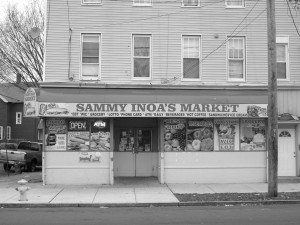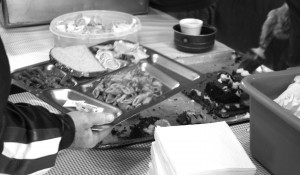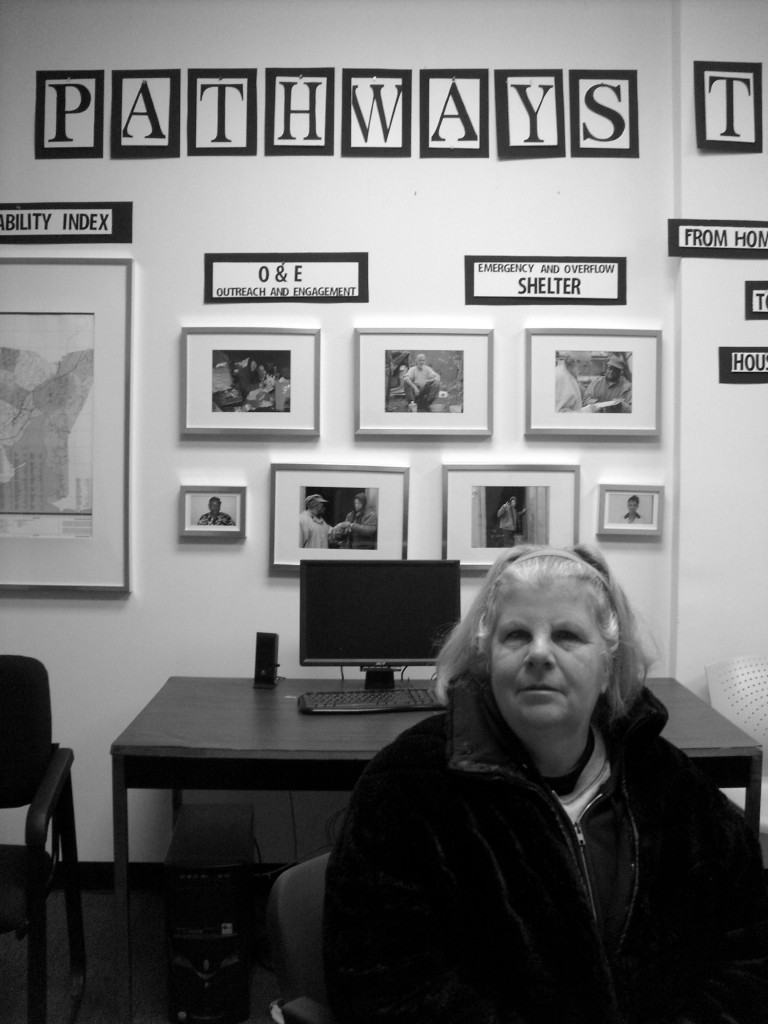
In a small apartment in Fair Haven, Patricia Stuart goes to get a letter from her bedroom. Family Feud plays in the background as she emerges with an envelope in hand, and begins to read in a low, gravelly voice: “In accordance with the American Recovery and Reinvestment Act of 2009, maximum allotments can only remain the same each year until the regular Thrifty Food Plan adjustment increased allotments above those set by the Recovery Act.” In comprehensible terms, the news is bad: her food stamp benefits have been cut from two hundred dollars a month to $189.
“What are we supposed to do?” she had asked soon after I walked in. Stuart, a tall, middle-aged woman wearing a colorful robe, spends most days at home or in the doctor’s office. Seated at her living room table, she shows me why she has been out of work for the last few years—she cannot lift her right arm more than a couple of inches. “Just moving it hurts right now,” she says softly, before laying it gently back in her lap. When she needs to leave the apartment, her goddaughter drives her, because taking the bus causes panic attacks. She places the letter alongside financial statements, pill bottles, and a bouquet of plastic roses.
Stuart is one of over 36,000 New Haven residents who receive food stamps, officially known as SNAP benefits, through the Supplemental Nutrition Assistance Program. In 2009, the American Recovery and Reinvestment Act gave people like her across the country extra food dollars to get them through the hard times of the recession. That temporary boost ended on November 1, forcing many to adjust their budgets. Legislators had assumed that the economy would pick up by the law’s expiration date, but in the New Haven, unemployment has stubbornly remained at twelve percent, and the cost of living has gone up. Some Connecticut representatives are part of the battle: Representative Rosa DeLauro has protested vehemently against additional reductions, and Senator Chris Murphy made headlines for eating on a SNAP budget for nearly a week last spring.
Since the cuts, Stuart has kept an especially sharp eye out for coupons and sales. She bought five pounds of potatoes and a five-pound bag of flour for ninety-nine cents each at ShopRite. Once a month, she stops at a food pantry to get additional supplies. “I don’t eat too much of the fresh stuff,” she notes. In fact, she tries not to each too much at all. She grows weary when I mention that under the Farm Bill being debated in Congress, several billion food stamp dollars may be cut once more.
On a map of food insecurity in Connecticut, New Haven is a dark stain, indicating that people here are worse off than those in the rest of the state. The portion of city residents on food stamps has approached thirty percent in the past few years, and the problem is worsened by governmental disorder. In the spring of 2013, a federal judge ordered that the Connecticut Department of Social Services (DSS) fix its “systemic deficiencies,” including illegally long wait times and frequent loss of applications.
But by the numbers, fewer people go hungry in Connecticut than in other parts of the country. In New Haven, the DSS has embarked a path of modernization, and nongovernmental resources are also readily available to residents. There are numerous soup kitchens, food pantries, and shelters. People spend at farmers’ markets, which double the value of their SNAP dollars and give them greater access to fresh fruits and vegetables. When asked if people are hungry in New Haven, Robert Jackson, a supervisor at the New Haven Community Soup Kitchen, says they shouldn’t be. Holding a mop in his emptied dining hall, he notes matter-of-factly: “There are so many places that feed you.”
*
But the lines keep getting longer. With the food stamp cuts arriving right before Thanksgiving and not long before the winter cold, people have turned increasingly toward nonprofit aid. The city’s charitable network finds itself spread thin.
On a Tuesday morning at the New Haven Community Soup Kitchen, Rick Durance, the assistant to the executive director, says, “December is looking bad, and January is going to be worse.” A former Michigan resident and AmeriCorps volunteer, Durance moved to Connecticut to work at Christ Church Episcopal in downtown New Haven, which runs the soup kitchen. In that time, he’s seen the numbers of meals the kitchen serves jump. Now, in the last week of every month, the one-room dining hall prepares to serve an unprecedented three hundred lunches. Durance expects the figures will only increase as New Haven starts to feel the effects of the SNAP cuts. “Folks are feeling shunned,” he says, “We’re feeling unable to provide for a community we care about.”
David O’Sullivan, Durance’s soft-spoken boss, tells me that the clientele has changed considerably in the twenty-seven years he has worked at the kitchen. When he started, he says, the typical beneficiary was an older male with a drinking problem. Now, the people who come looking for a meal are, on the whole, younger, whiter, more well-to-do, and sometimes toting kids. “For a lot of the newer folks, you can sense the stress levels are higher,” he tells me. They come in asking for assistance the soup kitchen cannot provide—diapers, baby food, rent assistance. Though a SNAP coordinator is sometimes on hand to direct them to the Department of Social Services, O’Sullivan says, “The government has stepped back.” The annual twenty thousand dollars in governmental funds that Christ Church Episcopal had received for the past five years has been cut. Now the directors have to rely on grants, donations, and fundraisers.

I leave just as the first of the lunch crowd files in. They make their way towards stacks of bread and pots of hot food fresh from the adjoining stainless-steel kitchen. With Farm Bill cuts of anything between four and forty billion dollars over the next ten years, Durance fears that soup kitchens and food pantries will not be able to handle the demand. “They will close, unequivocally,” he says, with a hard look in his eyes. He hopes, however, that his kitchen will be an exception.
*
Those who cannot line up for cooked meals often stock their own fridges and cupboards with the help of food pantries instead. The following Saturday, I am standing in front of the Episcopal Church of St. Paul and St. James. The church runs Loaves & Fishes, the largest weekly New Haven pantry that allows its guests—as the program manager, Reverend Keith Voets, calls them—to pick out their own food. Voets had told me that people line up well before the pantry’s 9 a.m. opening. When I arrive at 8:30, there is already a line around the block.

Inside, John Castillo, the church’s good-natured caretaker, directs me to the serving area. A food stamp recipient himself, he seems mostly unfazed by the SNAP reduction: “It has caused me to cut back a little on red meat, but other than that it’s basically the same.” Yet the times are not easy for him: he tells me about his multiple sclerosis and how his household includes his six younger siblings, all in the same cheerful tones with which he had given me directions. Pay from the church is not enough for Castillo to go without assistance, but he says that New Haven has offered him much more support than New York, where he grew up. Plus, he insists, he fares better than some others who are struggling here. As we speak, someone in the next room yells, “We’re about to get started,” and the volunteers’ opening prayer drifts through the door: “Give us today our daily bread…”
Loaves & Fishes gets most of its food from the Connecticut Food Bank, one of two large food assistance banks in the state. The CT Food Bank, whose central location is in nearby East Haven, also relies on donations from local markets and growers. Government food provisions have run thin, and the decline is expected to continue. Neither the Food Bank nor the pantries know how many of the people who come in are on food stamps, but with more cuts to come, CT Food Bank Communications Director Mary Ingarra says the Food Bank is expecting more of a strain on its programs.
Back in the volunteer area of Loaves & Fishes, the strain is visible. Volunteers shuttle around quickly, cutting pie for guests and bagging bread to deliver to elderly people at home. A teenage girl hurtles by, saying, “We have an egg spill. Eggs are down.” A white-haired man peers out of the kitchen to ask, “Does anyone know how to make coffee in these things?” Another, wearing a pink sweater and jeans, declares, “Straight-up chaotic today.”
In the next room, a volunteer holds up numbered laminated papers to make sure guests reach the food tables in an orderly fashion. Individuals who arrive with their own bags get an extra item from a table with Thanksgiving staples like stove-top turkey stuffing, while the rest move on to the standard fare: packets of rice, cans of sweet corn and green beans, bags of potatoes, and fresh zucchini. A chart on the wall displays pictures and labels of lesser-known fruits and vegetables, including yucca and various kinds of yautía—presumably part of the young new reverend’s plan to make guests’ diets more nutritious. Loaves & Fishes also runs a small free medical clinic, and the rates of diabetes and obesity that volunteers see are staggering, Voets says.
Two older women cross in front of me. “Venga por aquí,” one says to the other. Another woman runs forward saying, “Wait, wait, wait,” before grabbing the hand of a small child. Loaves & Fishes does not ask any questions of its guests, so it does not have statistics on its clients’ demographics, but one can observe the people who mill about. The pink-sweatered volunteer declares that many are drug addicts who trade in their SNAP swipes for cash at local grocery stores and then show up at the pantry. Nationally, only one cent on every SNAP dollar spent is illegally exchanged for cash, a fraud rate that has dropped in recent years. Both Voets and volunteer captain Sally Fleming tell me that many of their guests are working poor, people with one or more low-wage jobs who still struggle to make ends meet. Fleming, a small, gray-haired woman who slips in and out of sight as other volunteers ask for her assistance, says, “I don’t think anyone’s starving, but there are certain families that run out of food and have to live on pasta by the end of the month.”
*
For the homeless, who have nowhere to store food or cook meals, options are even more limited. Yet the shelters they turn to are not always able to provide the food they need. At Columbus House, one of New Haven’s largest homeless shelters and social service organizations, Paula Bowe explains that she is borderline diabetic, and it’s crucial that she maintains a healthy diet—with fresh vegetables, lean meat, fish, and not too many carbs—to prevent the disease from worsening. “It’s the stuff that you’re not supposed to have that you can afford,” she says, seated at a table in the shelter’s office space. Columbus House Intake Specialist Martha Deeds, a young woman with short-cropped blonde hair, points out that though homelessness often exacerbates people’s health issues, the shelter cannot cater to all dietary restrictions. “The options are limited,” she says.
Bowe speaks vehemently about her fight to support herself—and her adult disabled son—within the system she depends on. She lost her longtime job as a clerk at Stop & Shop three years ago, after a car accident sent her to the hospital. She lived off savings and settlement money for months, but both have run out, forcing her to seek help at Columbus House. She struggled with the Department of Social Services; her SNAP benefits were cut off when her renewal form was sent to her old mailbox. When she applied again, the office misplaced her documents. Like others, she has become jaded: “If my body would let me, I’d rather work eighty hours a week than deal with the federal or the state government.” I ask her about the department’s new office, which has made use of a statewide system to manage clients’ accounts online and a new scanning process to prevent lost documents. There’s more staff and wait times have decreased significantly, but after her fight, Bowe remains skeptical: “It’s the same old welfare office.”
Work is hard to come by for Bowe, given that she cannot operate a computer easily, which she says is required for most jobs. Though the state has stepped in to cover her future rent, paying utilities without an income is impossible. She hopes to move out of Columbus House as soon as possible, but she worries that even with a kitchen, she will struggle to prepare healthy meals. For now, she practices her computer skills in the hopes of finding employment.
*
To successfully advocate against future cuts, those affected need to tell their stories, says William Bromage, chair of the Food Assistance Working Group, and they need to do it well: “Everyone can tell their story, but not everyone can do it concisely and powerfully.”
The group is part of the New Haven Food Policy Council, which has banded together with local nonprofits to train a few people to do so. The twelve chosen food advocates come from all over New Haven, and most rely on assistance—whether from SNAP, soup kitchens, or food pantries. In October, they attended a five-hour training session to learn how to speak at a legislative hearing, write letters to newspaper editors, and reach out to fellow community members.
The advocates are paid for an eleven-hour internship, anything from attending conferences to assisting with surveys to—I’m unnerved to learn—speaking with reporters. But Bromage points out that the $12.50-per-hour compensation is necessary when dealing with such a low-income population. There are, of course, barriers to what they can do. At one council meeting, food advocate Kimberly Hart complains, “Policymakers can testify for hours. When I testify? Three minutes.” And perhaps there is some heartstring-pulling.

Patricia Stuart, who lives in Fair Haven, is another one of the food advocates. Initially she speaks of the food stamp cuts with resignation: “There’s no sense in trying to fight it, because you won’t win.” But she attended part of the food advocate meetings, and plans to return. Among people like her, there’s a sense of collective vulnerability. The poor, especially those who struggle with multiple jobs or impermanent housing, are often not the ones closely following federal debates. Faraway politicians hand down decisions, and the consequences, announced in the formal language of legislation, translate to a lost gallon of milk, or one more bruised tomato.
The food advocates are just a handful of New Haven citizens, but they represent many others. In conversation, they tell the stories of people—a friend with kids, a woman in the street, a couple featured in the paper—who are struggling more than they are. They speak not the language of policymakers but instead the language of empty shopping carts and skipped meals. Their perspective, they hope, will change the spirit of the debate—if lawmakers hear them.


